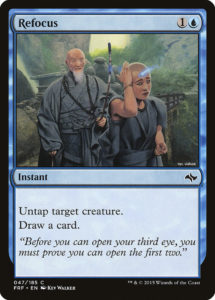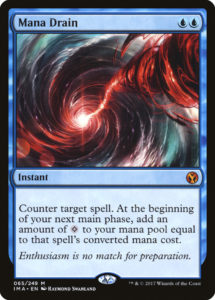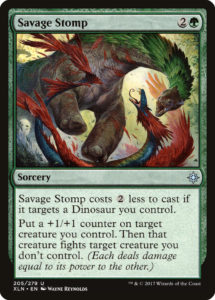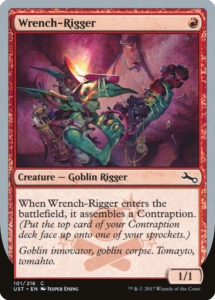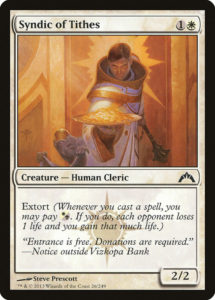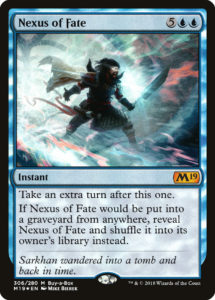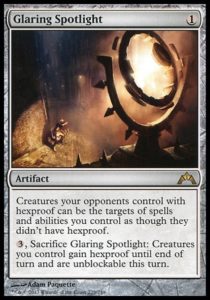So, this has been quite a year. As my birthday approaches, I’d like to spend today taking stock, both for myself and for the game we devote ourselves to so thoroughly. It’s a little indulgent, but hey, it’s been a wild year for Magic, and also a pretty good one for me, too.
My year was pretty inwardly focused—I’m now a year out of grad school and further into my career. I’ve worked hard on Hipsters, Kingdom Death, and a few side projects. This has had the nice benefit of wrenching my bank account balance comfortably above its dismal state at the end of school. I’ve made a bunch of monsters for KD:M, taken on a host of new responsibilities at work, and had the privilege to teach brilliant young game designers at the AMNH. At Hipsters, I had the joy of running Great Designer Training and the privilege of revealing a whopping five preview cards for Dominaria and Core 2019. This year has been exciting and wonderful, and I intend for next year to be both better and different. But let’s talk about what we’re all here for—Magic.
HasCon and the Masters Line
The inaugural HasCon was almost a year ago. It was a smashing success that’ll be back in 2019 and was wonderful to attend with the Hipsters entourage. We had the privilege of livestreaming the first-ever Iconic Masters event and recording the first draft. The set was fun to play, but ultimately flopped. The nebulous theming and inaccurate name featured a weird Limited environment. The early spoiling allowed the market to adjust, deflating the set’s value months before it released. The set was reliant on low supply, low demand cards like Mana Drain to justify its hefty price tag. You can still see the damage to this day in NYC, as stores are still trying to unload product at well below MSRP. Six months later, Masters 25 attempted to buck this trend but unfortunately only followed suit. It was just too expensive, too close on the heels of another Masters set, too low in value, and confirmed both community and LGS fears about the overprinting and devaluing of Masters products.
In a single year, we’ve gone from Masters becoming biannual products with a strong focus on theme, to gone. There has been no word of future Masters offerings since Masters 25, which makes sense—I think stores are going to be really careful about how much Masters product they order in the future (unless their price drops or their value is through the roof). This is unfortunate, because the Masters series is my favorite supplementary product—a high value, high power Limited format. Still, this tenuous position is a consequence of the past year’s problems.
Ixalan, Dominaria, and the State of Limited
Ixalan was the nadir of Limited for me. Since Scars of Mirrodin, no set has been so unfun that I stopped playing it, until Ixalan. Ixalan’s worldbuilding, story, and art were truly spectacular, but the gameplay was so restrictive, the set mechanics so uninteresting, and the balance so skewed, that I just didn’t want to play. When this year’s schedule was posted with a dearth of local Limited Grand Prix (excepting a shockingly large amount for Core 2019), I wasn’t too disappointed—I’d skipped the main event at the most local Grand Prix I’ll ever have (GP New Jersey) purely because I couldn’t stand to play the format any more. Rivals of Ixalan reinvigorated the draft scene (though its plethora of bomb, interactive rares made Sealed PPTQs and GPs quite frustrating), but the two block paradigm was essentially defined for me as lackluster large sets supported by strong small sets. The coming elimination of small sets made me worry that I’d be stuck with only large sets I didn’t enjoy, and that made me afraid I might not want to play Magic any more.
Then the single block paradigm began with Dominaria, and Wizards proved they could once again bottle lightning and make a truly spectacular large set Limited format. I hope that Dominaria is a precursor of many more good things to come, and fewer Ixalans and Kaladeshes.
Supplemental Products
Unstable is perhaps the Magic product I was least excited to see in my entire 24 years of playing the game. Things like Duel Decks and Portal were never meant for me, so I wasn’t losing anything for them existing. However, Unstable took up the innovation product slot, meaning we didn’t get another Conspiracy or other product that I could draft and put into my cube. I wrote multiple articles about the hurdles Unstable would have to jump just to be an acceptable product, how the chips were stacked against it, and how I was not the target demographic.
Oh, how wrong I was. Unstable is the greatest gift Magic has given me that I didn’t know I needed since I discovered Magic. The Limited environment is dynamic, complex, and deep. The humor isn’t sophomoric as Unhinged’s was, and cards are meant to be played with, instead of enjoyed from afar (as Unglued’s cards always seemed to be). Unstable rekindled my faith in Wizard’s vision just as Dominaria made me fall in love with large set Limited again.
Battlebond, on the other hand, had all the hallmarks of success. It had new cards for Legacy, Commander, and Cube. It was a normally-priced, draftable product. Unfortunately, it followed two lackluster Masters products, so stores bought very little of it and only ran events for the week of release. Moreover, Battlebond relies on having a partner to attend an event, meaning players can’t just show up and play (or if they do, they have to navigate the social awkwardness of drafting, playing, and splitting prizes with a stranger). I can’t tell you how good Battlebond was because I was never able to play it. I wish I had, but I don’t think I’ll have the opportunity. I really thought I would at Gen Con, but there was no Battlebond draft and we couldn’t schedule our breaks to play a Sealed event.
Aside from those two, we saw the introduction of Challenger Decks (a brilliant move, and one which I hope is repeated regularly to drop the entry point of Standard). Signature Spellbook replaced From the Vault as cheaper way to print premium cards that’s still not for me. Global Series was also not for me, but hopefully was well-received by its audience (even though its power level was quite low).
The Great Designer Search 3
I had a complete blast preparing for GDS3. It made me reread all of GDS2 and 1, which was fun in and of itself. It led me to run Great Designer Training, a tremendous opportunity (and made me a Jeremy Geist fan for life). I wish I’d done better, but such is life.
I didn’t enjoy watching the competition nearly as much as I hoped I would. GDS2 was great entertainment and education, whereas GDS3 didn’t strike a chord with me in either vein, even though I actually knew folks in the top 8. The long periods with no news, the crunched publication, the limited feedback, and the challenges themselves were disappointing. I look forward to seeing what comes of the competition, but I wish it had been more entertaining or confidence-inspiring in how employees are tested and evaluated. I do love how open Wizards is with their design processes and relish seeing more, but I think for now I’m more excited to read about it than yearn for GDS4 being around the corner.
Standard and Modern
Standard’s had a rough couple of years. We’ve seen nine cards banned across four B&R announcements from January 2017 to January 2018. The last time this happened was Mirrodin block, and six of those nine cards were all the same mistake in artifact lands. Since the last banning, Standard has been heavily dominated by red aggressive decks but settled into something fairly balanced right now. Standard looks like it may recover, which it must if Magic is going to survive in its current form.
Standard already saw the introduction of legal cards not in booster packs thanks to Planeswalker decks and welcome decks. Firesong and Sunspeaker and Nexus of Fate were introduced to help out local game stores now that they have to increasingly compete with both the internet and massive retailers and have lost previous moneymakers like From the Vault. I recognize that this can set a dangerous precedent if the next Teferi or Karn is a Buy-A-Box promo, but this is also a fixable problem (Nexus of Fate isn’t on a Reserved List) and we’re in the Feedback Era where Magic is being extra-attentive to its fans’ opinions. I think that the Standard bannings of 2017 opened up the game to a lot more criticism than normal (and made players more complacent than they’d otherwise be about trying to break Standard). I think it’s a very good thing that players are complaining about a card’s availability in Standard rather than whether Standard is playable because of Copycat or Aetherworks Marvel.
And Modern, well, Modern’s fantastic. It’s a deep format with a wealth of diversity, as it’s always been. Standard being damaged gave Modern the spotlight and I’ve never seen it so popular before. It’s my favorite Constructed format by a mile and I’m delighted to both have so much content to watch as well as be playing it again after quitting it for two years thanks to Eldrazi Winter.
Looking Ahead
With three and a half months left in the year, there’s basically nothing on the slate besides Commander 2018 and Guilds of Ravnica. There’s no Masters set, no innovation product, nothing. It’s funny—I’ve gone from hating the seemingly ceaseless summer releases to enjoying a relaxing summer playing little of Core 2019 (because core set Limited never stays fresh for long for me), to realizing there’s only one product for me between April’s Dominaria and next January’s Ravnica Allegiance: October’s Guilds of Ravnica. I’ve gone from being overserved by biannual Masters products and innovation products to having nothing besides the main set releases. Magic’s 25th anniversary had some huge ups and downs between the highs of Unstable and Dominaria and the lows of Iconic Masters, but the year seems to be ending with a whimper rather than a bang.
Locally, I wonder how Magic is going to remain sustainable in New York City. The price of a booster pack hasn’t budged since I returned to the game in 2010. The price of an LGS booster box has actually decreased to compete with online retailers. The price of a draft has remained stagnant at most stores, increasing by 15% at others. Ixalan was horrible for confidence in Limited, all my accounts say that Masters sets were horrible for stores, and Standard was never all that strong in NYC to begin with. Modern is going strong and Dominaria proved that the Limited ship can be righted, but I wonder how LGSes in a city with rent as expensive as NYC’s can countenance running MTG when they can more money giving players table space for board games and selling food and beer, and when another failed Masters release could push them away from Magic altogether.
Magic isn’t in a perfect spot this year, but then again, it never is. The past year has seen the righting of the good ship Standard, the best Limited format since Khans of Tarkir (in my obviously biased opinion), and the most surprisingly awesome innovation product ever in Unstable. Sure, there were missteps along the way, but this is Magic—you get to choose how and when you engage with the game, and Standard and Limited (and for NYC, Modern), are how enfranchised players engage with the game the most, all of them have been this year or are in good places right now. Here’s looking forward to another experimental year that hopefully shines even brighter, both for Magic, and for me.
And, as always, thanks for reading.
—Zachary Barash
Zachary Barash is a New York City-based game designer. He designs for Kingdom Death: Monster, has a Game Design MFA from the NYU Game Center, and does freelance game design. When the stars align, he streams Magic.
His favorite card of the month (and all time) is Prophetic Prism. It’s quintessentially fair, enormously powerful, and allows incredible greed at a reasonable cost (but little opportunity cost). Also, every version of its art is unspeakably beautiful.

